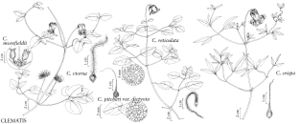Difference between revisions of "Clematis reticulata"
Fl. Carol., 156. 1788.
FNA>Volume Importer |
GeoffLevin (talk | contribs) m (Edited synonyms to match printed version) |
||
| (8 intermediate revisions by 2 users not shown) | |||
| Line 12: | Line 12: | ||
}}{{Treatment/ID/Special_status | }}{{Treatment/ID/Special_status | ||
|code=F | |code=F | ||
| − | |label= | + | |label=Illustrated |
}} | }} | ||
|basionyms= | |basionyms= | ||
| Line 18: | Line 18: | ||
|name=Viorna reticulata | |name=Viorna reticulata | ||
|authority=(Walter) Small | |authority=(Walter) Small | ||
| − | }}{{Treatment/ID/Synonym | + | |rank=species |
| − | |name= | + | }} {{Treatment/ID/Synonym |
| + | |name=Viorna subreticulata | ||
|authority=Harbison ex Small | |authority=Harbison ex Small | ||
| + | |rank=species | ||
}} | }} | ||
|hierarchy=Ranunculaceae;Clematis;Clematis subg. Viorna;Clematis reticulata | |hierarchy=Ranunculaceae;Clematis;Clematis subg. Viorna;Clematis reticulata | ||
| Line 29: | Line 31: | ||
}}<!-- | }}<!-- | ||
| − | --><span class="statement" id="st- | + | --><span class="statement" id="st-undefined" data-properties=""><b>Stems </b>viny, to 4 m, glabrous or sparsely pilose-pubescent, sometimes more densely pubescent near nodes. <b>Leaf</b> blade 1-pinnate; leaflets 6-8 plus additional tendril-like terminal leaflet, elliptic to ovate, unlobed, 1-3-lobed, or proximal 3-foliolate, 1-9 × 0.5-5(-7.5) cm, leathery, prominently and finely reticulate abaxially and adaxially; surfaces abaxially silky-pubescent, not glaucous. <b>Inflorescences</b> axillary, 1-3-flowered; bracts about 1/3 distance from base of peduncle. <b>Flowers</b> urn-shaped; sepals pale lavender to purple, greenish toward tip, ovate-lanceolate, 1.2-3 cm, margins not expanded, ± thick, not crispate, densely tomentose, tips acute, recurved, abaxially usually ± densely yellowish pubescent, occasionally nearly glabrous. <b>Achenes</b>: bodies appressed-pubescent; beak 4-6 cm, plumose. <b>2n</b> = 16.</span><!-- |
-->{{Treatment/Body | -->{{Treatment/Body | ||
| Line 36: | Line 38: | ||
|elevation=0-150 m | |elevation=0-150 m | ||
|distribution=Ala.;Ark.;Fla.;Ga.;La.;Miss.;Okla.;S.C.;Tex. | |distribution=Ala.;Ark.;Fla.;Ga.;La.;Miss.;Okla.;S.C.;Tex. | ||
| − | |discussion=<p>In immature fruit, especially, the vestiture of the beaks of Clematis reticulata might not consistently suffice to distinguish it from C. pitcheri, which has appressed-pubescent beaks. Clematis reticulata is distinguished from C. pitcheri by the very fine reticulation of the leaves, with the smallest areoles completely enclosed by veinlets generally less than 1 mm long and even the quaternary veins prominently raised on the adaxial surface.</p> | + | |discussion=<p>In immature fruit, especially, the vestiture of the beaks of <i>Clematis reticulata</i> might not consistently suffice to distinguish it from <i>C. pitcheri</i>, which has appressed-pubescent beaks. <i>Clematis reticulata</i> is distinguished from <i>C. pitcheri</i> by the very fine reticulation of the leaves, with the smallest areoles completely enclosed by veinlets generally less than 1 mm long and even the quaternary veins prominently raised on the adaxial surface.</p> |
|tables= | |tables= | ||
|references= | |references= | ||
| Line 45: | Line 47: | ||
-->{{#Taxon: | -->{{#Taxon: | ||
name=Clematis reticulata | name=Clematis reticulata | ||
| − | |||
|authority=Walter | |authority=Walter | ||
|rank=species | |rank=species | ||
|parent rank=subgenus | |parent rank=subgenus | ||
| − | |synonyms=Viorna reticulata; | + | |synonyms=Viorna reticulata;Viorna subreticulata |
|basionyms= | |basionyms= | ||
|family=Ranunculaceae | |family=Ranunculaceae | ||
| Line 59: | Line 60: | ||
|publication title=Fl. Carol., | |publication title=Fl. Carol., | ||
|publication year=1788 | |publication year=1788 | ||
| − | |special status=Endemic; | + | |special status=Endemic;Illustrated |
| − | |source xml=https:// | + | |source xml=https://bitbucket.org/aafc-mbb/fna-data-curation/src/2e0870ddd59836b60bcf96646a41e87ea5a5943a/coarse_grained_fna_xml/V3/V3_255.xml |
|genus=Clematis | |genus=Clematis | ||
|subgenus=Clematis subg. Viorna | |subgenus=Clematis subg. Viorna | ||
|species=Clematis reticulata | |species=Clematis reticulata | ||
| − | |||
| − | |||
| − | |||
| − | |||
| − | |||
| − | |||
| − | |||
| − | |||
| − | |||
| − | |||
| − | |||
| − | |||
| − | |||
| − | |||
| − | |||
| − | |||
| − | |||
| − | |||
| − | |||
| − | |||
| − | |||
| − | |||
| − | |||
| − | |||
| − | |||
| − | |||
| − | |||
| − | |||
| − | |||
| − | |||
| − | |||
| − | |||
| − | |||
| − | |||
}}<!-- | }}<!-- | ||
-->[[Category:Treatment]][[Category:Clematis subg. Viorna]] | -->[[Category:Treatment]][[Category:Clematis subg. Viorna]] | ||
Latest revision as of 19:05, 7 December 2022
Stems viny, to 4 m, glabrous or sparsely pilose-pubescent, sometimes more densely pubescent near nodes. Leaf blade 1-pinnate; leaflets 6-8 plus additional tendril-like terminal leaflet, elliptic to ovate, unlobed, 1-3-lobed, or proximal 3-foliolate, 1-9 × 0.5-5(-7.5) cm, leathery, prominently and finely reticulate abaxially and adaxially; surfaces abaxially silky-pubescent, not glaucous. Inflorescences axillary, 1-3-flowered; bracts about 1/3 distance from base of peduncle. Flowers urn-shaped; sepals pale lavender to purple, greenish toward tip, ovate-lanceolate, 1.2-3 cm, margins not expanded, ± thick, not crispate, densely tomentose, tips acute, recurved, abaxially usually ± densely yellowish pubescent, occasionally nearly glabrous. Achenes: bodies appressed-pubescent; beak 4-6 cm, plumose. 2n = 16.
Phenology: Flowering spring–summer (May–Jun).
Habitat: Dry woods and thickets in sandy soils
Elevation: 0-150 m
Distribution

Ala., Ark., Fla., Ga., La., Miss., Okla., S.C., Tex.
Discussion
In immature fruit, especially, the vestiture of the beaks of Clematis reticulata might not consistently suffice to distinguish it from C. pitcheri, which has appressed-pubescent beaks. Clematis reticulata is distinguished from C. pitcheri by the very fine reticulation of the leaves, with the smallest areoles completely enclosed by veinlets generally less than 1 mm long and even the quaternary veins prominently raised on the adaxial surface.
Selected References
None.
